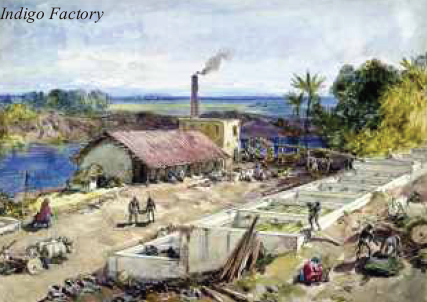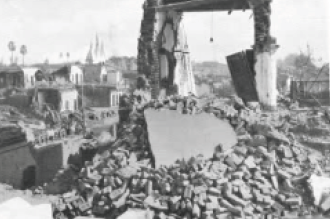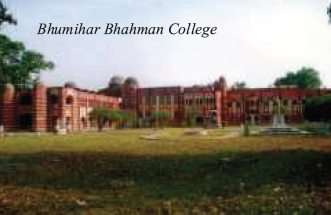Muzzafarpur
(Created page with "{| class="wikitable" |- |colspan="0"|<div style="font-size:100%"> This is a collection of articles archived for the excellence of their content.<br/>You can help by converting...") |
Latest revision as of 22:19, 18 January 2014
This is a collection of articles archived for the excellence of their content. Readers will be able to edit existing articles and post new articles directly |
[edit] Muzzafarpur
...of Indigo and Shahi Lytchees
By Kulsoom Noor Saifullah
India Harmony VOLUME - 1 : ISSUE - 6 SEPTEMBER-OCTOBER, 2012
Flowing down from the Someshwar Hills in the Himalayan region of Nepal is the perennial Burhi Gandak river. It meanders through the alluvial indo gangetic plains of Bihar bringing down silt and sand from glaciers and rain fed rivers to feed the saucer shaped, low centered town of Muzzafarpur. This ancient town basking in verdant beauty dotted with ponds and oxbow lakes, has had to constantly renew itself. Ravaged by floods and earthquakes, the last one in 1934 causing widespread death and destruction, Muzzafarpur stands tall,refusing to be obliterated. It is a triumph of the spirit of its inhabitants,rooted in ancient history and cultural evolution that makes Muzzafarpur one of Bihar’s most eminent cities. Though named after an Afghan, Mohammed Muzaffar Khan, a revenue officer deputed by the Mughals to set up a cantonment there in the sixteenth century, the region is dotted with relics of a rich and varied past that traces its beginnings to the Vrijjan Republic that existed almost 3000 years ago when this area was known as Vaishali. Muzzafarpur is India’s gateway to Nepal and China and has been an important trade centre through the centuries, an eminence that remains to the present day. Whether it was the export of Buddhism to China or the import of the lytchee plant from China, the city has contributed greatly to the intellectual and economic moorings of the region. From the times of Ghiasuddin Tughlag, the Afghans and Mughals exercised control over this fertile plain forwellover six hundred years. However, it was during the British Raj, that Muzzafarpur saw great prosperity, due to its rich soil which made it suitable for indigo cultivation. British and European Planters started to arrive here and soon the area was dotted with indigo plantations. The Europeans set up schools, colleges, churches and clubs, exposing the local residents to yet another alien culture.
The city now displayed a cosmopolitan ambience. The planters club became a centre for social interaction. A magnificent club house surrounded by rolling green lawns sloping down to the river; A ballroom where many a young planter found his bride; A lounge, called the snake pit, where women spewed venom over knitting and reputations were torn to shreds; A Bar where the days business was done; A card room where fortunes were made or lost in a day; Children frolicked around staring in wonder at the hunting trophies, large stuffed animal heads staring down from the walls; billiards,tennis, badminton - there was something for everyone! Life was good. With prosperity, came the missionaries and educationists.The Central College and Greer Bhumihar Brahman College came up producing some of India’s finest thinkers, teachers and administrators. Dr. Rajendra Prasad, India’s first President was amongst them. Sir Syed Ahmed, founder of the Aligarh Muslim University, set up the Bihar scientific society here, Pandit Madan Mohan Malviya received heavy donations from local landlords to establish the Banaras Hindu University
The Europeans brought western science and thought here and studied Persian and Hindu treatises.Orientalists and Indologists returned from here to Europe with glowing accounts of the Indian civilization. Alas! this idyllic existence could not last for long.
With education came awareness and the plantation labour soon began to chafe under the exploitation of the British factories. The winds of change were sweeping in from distant Calcutta. There were new aspirations and new heroes. The city hosted a grand civic reception for the poet laureate Rabindra Nath Tagore in 1902. Mahatama Gandhi, on a brief visit in 1918 left behind dreams of equity and freedom. There was change in the air. Rich landlords took to khadi and joined the freedom movement. The earthquake of 1934 almost decimated the city. The planter’s club lay in ruins.With the invention of synthetic indigo,the indigo plantations lost their sheen. In 1947 India gained freedom. The people of free but impoverished Muzzafarpur slowly began to rebuild the city. What remained was the city’s intellectual and spiritual legacy. It’s residents had imbibed vibrant spiritual influences starting from the Shiva worshippers to the Buddhist, Islamic and Christian teachers. Miraculously, their places of worship survived the calamity.The Baba Garib Nath temple, the impressive Chaturbhuj temple, the Dargah of Hazrat Ismail Shah and the St Mary,s church continue to draw the faithful to this day. The city grew but in a haphazard, unplanned manner. Civic amenities lay destroyed. But, what came to the rescue of the area was the humble lytchi. The Raja of Darbhanga was a passionate advocate of education and research.Under his patronage a research station of lytchees was set up where European horticulturists were invited to improve it's quality and yield. Over the last few decades under the aegis of the Indian Council of Agricultural Research different varieties of lytchees were propagated. In 2001 the National Research for Lytchees was established. Lytchee cultivation in Muzaffarpur has placed the city in the forefront of lytchee production in India. The region accounts for nearly 90 percent of India’s production; but, lamentably ,only supplies 1% of global demand. However,it is only a question of time before the soft, succulent Shahi Lytchee takes Muzzarfarpur back to that glorious era of lost prosperity.




